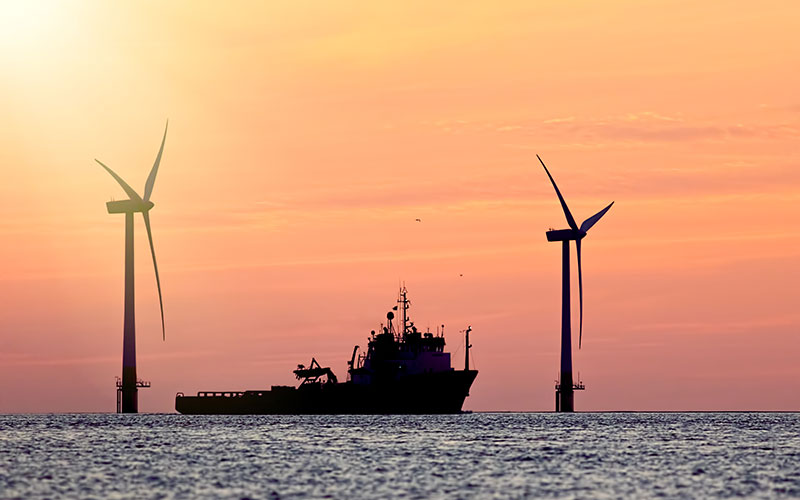Accelerating the offshore energy transition
The UK is in pole position to help accelerate offshore low-carbon energy innovation, both at home and overseas – but collaboration is key, writes Lucy Woods

The energy sector is in the middle of a mass transition. The race to decarbonise and switch to renewable energy will present many challenges and opportunitiesthroughout the global industry – including opportunities for international collaboration. In the offshore energy sector, the UK is building on its globally recognised expertise to lead the energy transition and meet its net-zero carbon target for 2050. In the US, lessons from Europe’s veteran offshore workforce are being adopted by its nascent offshore wind industry.
UK offshore transition
Last December, to help the UK industry reach the 2050 deadline, the UK Oil and Gas Authority (OGA) published a first phase report for the UK Continental Shelf Energy Integration project. The project aims to unlock integration opportunities, including how oil and gas infrastructure can be used for carbon capture and storage (CCS), wind and hydrogen facilities, and how oil and gas operators and the supply chain can partner up with renewables.
‘The UK’s infrastructure, subsurface reservoirs and expertise, along with a world-class supply chain, which is already diversifying into renewables, make it well-placed to be a global leader in the energy transition,’ states Andy Samuel, OGA Chief Executive, in the report’s foreword.
Teaming up for opportunities
OGA spokesperson Simon Belgard told Energy Focus that existing oil and gas infrastructure is contributing to the transition with offshore terminals and pipeline networks, which are ‘prized assets for CCS as well as hydrogen and for transporting carbon dioxide offshore.’
The report recommends closer partnerships between offshore oil and gas and renewables for platform electrification and reducing oil and gas offshore installation emissions by using renewable electricity from wind turbines instead of diesel. ‘Old oil platforms can host electric transformers and substations to allow more rapid expansion of wind power,’ says Belgard.
Another offshore transition technology suggested by the report is ‘gas-to-wire’, whereby gas can be converted offshore to electricity, then transported using existing wind energy distribution cables. Also using offshore infrastructure, natural gas can be produced offshore and converted to hydrogen using methane reforming with carbon dioxide, then stored in offshore reservoirs. These ideas present many opportunities for UK oil and gas and renewables entities to team up.
The conversion of distribution infrastructure to bring new energy forms, such as electric cars and hydrogen, to consumers is a significant challenge in the energy transition, says Belgard. To achieve full commerciality, the technology still has to evolve to reduce costs. However, as the UK’s energy supply chain has many highly relevant areas of expertise, including a world-class subsea capability, the UK ‘is well placed to support and benefit from the energy transition – both in the UK and overseas,’ according to Belgard.
The US has a total offshore wind pipeline of more than 26GW with 14 offshore wind projects totalling 9.1GW expected to be operational by 2026
Helping power US wind
This international collaboration in offshore energy transition is most apparent in the nascent US offshore wind energy industry. According to the American Wind Energy Association, wind energy generated 6.5% of the US’s electricity in 2018. However, only one offshore wind farm contributed to this: the 30MW Block Island Wind Farm.
In the the same year, 24.3% of the UK’s electricity came from offshore wind alone. The US industry ‘looks to Europe for experience as the leaders of offshore wind’ says Bruce Carlisle, Director for Offshore Wind at the Massachusetts Clean Energy Centre. ‘We have a lot of trade missions
to the UK, Netherlands and Denmark. This leads to conversations, business to business connections, and learning a lot from these industries.’
Although the US may be decades behind many European countries when it comes to offshore wind deployment, the last couple of years has seen an explosion of investment, procurement and construction. New York, New Jersey and Massachusetts states have co-invested together ‘on a large scale to help reduce the cost and improve efficiency,’ says Carlisle. The US offshore wind industry, ‘fully acknowledges that we are going zero to 60, from first to fifth gear,’ he adds.
With a 26GW aggregate pipeline in US for offshore wind, it is hoped that recent high investor interest, especially in the northeast of the US, will lower the levelised cost of energy (LCOE) during the next few years. The states of Maryland and North Carolina are specifically named as the next big markets to invest in.
The UK is well placed to support and benefit from the energy transition – both in the UK and overseas
‘We are paying close attention to European knowledge and how to reduce the LCOE, and there has been a consistent drop in prices, just like there was in Europe,’ says Carlisle. ‘We expect we will continue to see reductions in LCOE cost, especially over the next 20 years as various large and important sectors, such as transport and heat, look to decarbonise and electrify, requiring GWs of renewable electricity sources such as offshore wind.’
UK expertise in demand
The US offshore wind industry is hoping to shave 10 years off its development by learning from the European experience, says Carlisle. One of its most notable benefits is access to the UK supply chain – especially large-scale established wind turbine manufacturers. US entities ‘are building connections between European manufacturers and suppliers, so that it is easy to get companies onboard and for project agreements to be seamless,’ he adds. For the UK to benefit, Carlisle advises the offshore supply chain to find local US businesses ‘that can be upscaled and retooled and developed to meet the specifications to grow business in the US’.
Moving the US market forward
As well as supply chain needs, ‘some offshore wind job occupations do need additional bodies,’ admits Carlisle. The MassCEC 2018 Offshore Wind Workforce Assessment, using examples from Europe, found a skills gap: water transporters, maritime workers, marine equipment engineers, skilled trade workers and operation and maintenance technicians are needed to meet the demands of the growing US offshore wind industry.
‘The European experience makes it clear that integrated partnerships between industry organisations, trade unions, and community college and vocational school systems will be needed for the creation of an adequate pipeline of workers with the skills, experience, and credentials needed to work in the offshore wind industry,’ the report states.
To fill this offshore skills gap, MassCEC is going above and beyond to develop a competitive workforce, including introducing new training schemes at local education institutions such as Bristol Community College and the Massachusetts Maritime Academy, working with European partners to deliver expert training.
Carlisle revealed to Energy Focus that there is an initiative in the works to take US workers to Europe and Asia to work on offshore wind projects. ‘It is still in development, so I can’t name it, but it is apprenticeship work that will be continued when the workers are back in the US. It will take time, but once those apprentices are back, they can train others, gain more skills and abilities, and the US offshore wind workforce will grow.’
Image credit | Shutterstock






Follow us
Advertise
Free e-Newsletter